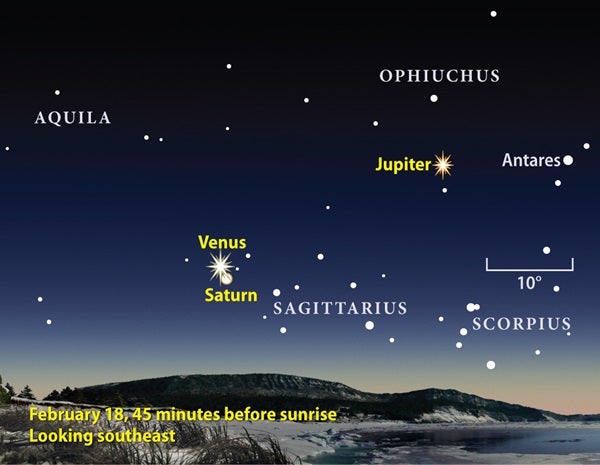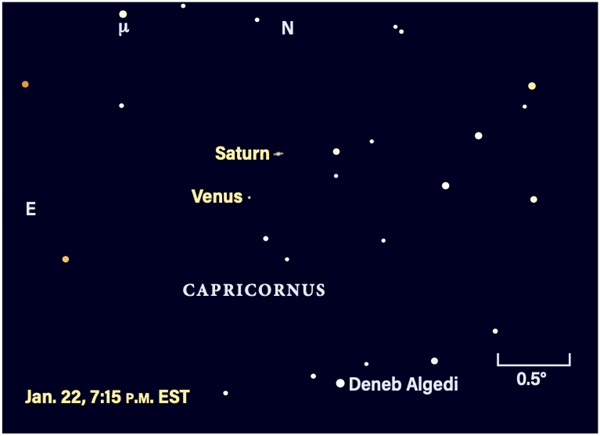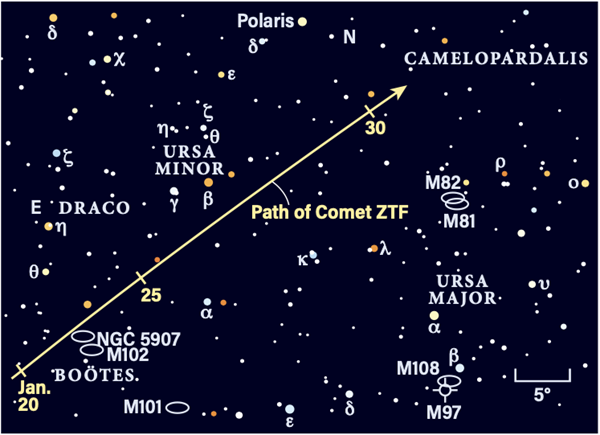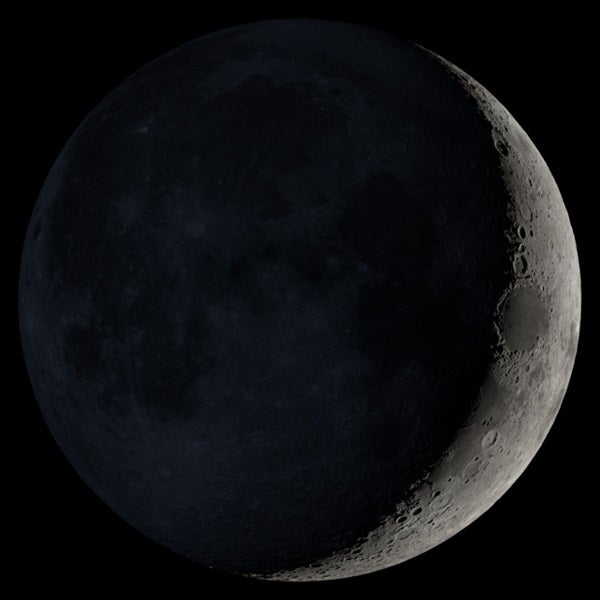Friday, January 20
The slim crescent Moon passes 7° due south of Mercury at 3 A.M. EST; both are below the horizon at the time but can be seen rising just before the Sun this morning instead, hanging in the pre-dawn twilight.
At 7 A.M. EST, mighty Jupiter reaches perihelion, the closest point to the Sun in its orbit. It will then stand within 460 million miles (740 million kilometers) of our star.
On the viewing docket for tonight is Neptune. The distant planet stands within 12′ of a 7th-magnitude field star this evening and some 5° north of asteroid 4 Vesta. Let’s start with Neptune: Shortly after dark, locate 4th-magnitude Phi (ϕ) Aquarii in Aquarius. With binoculars or a telescope, scan 5° northeast of this star to locate a parallelogram of four 7th-magnitude stars, each about 1° apart. Neptune is closest to the northeasternmost star in this shape, cataloged as HIP 116402. With both in the same field of view, compare the appearance of the star and planet. Neptune will appear bluer, with a “flat,” round appearance. The star will appear more as a brilliant pinprick of yellow-white light with no sharp outline.
Drop 5° south of this scene to pick up magnitude 8.2 Vesta, the second most massive body in the main belt. It lies just 20′ east of a 7th-magnitude field star. Watch for an hour or two to see whether you can detect the rocky world’s slight movement as it slips in a straight line northeast of the star.
Sunrise: 7:18 A.M.
Sunset: 5:05 P.M.
Moonrise: 6:34 A.M.
Moonset: 3:33 P.M.
Moon Phase: Waning crescent (2%)
*Times for sunrise, sunset, moonrise, and moonset are given in local time from 40° N 90° W. The Moon’s illumination is given at 12 P.M. local time from the same location.
Saturday, January 21
New Moon occurs at 3:53 P.M. EST. The Moon also reaches perigee, the closest point to Earth in its orbit, a few minutes later at 3:57 P.M. EST. Our satellite will then sit just 221,562 miles (356,569 km) away.
Let’s take advantage of the moonless skies to go extragalactic and enjoy the Milky Way’s largest neighbor: the Andromeda Galaxy (M31). Have you ever managed to snag this sight with your naked eyes? Give it a try from a dark location tonight; two hours after sunset, Andromeda is high in the western sky, appearing to the upper left of the Little Dipper in Ursa Minor. The galaxy itself, which sits just 1.5° west of magnitude 4.5 Nu (ν) Andromedae, appears as a spread-out, 4th-magnitude smudge of light that may be best seen with averted, rather than direct, vision.
Through binoculars or, better yet, at telescope, that smudge gets much easier to see. If possible, opt for a 4-inch or larger scope to start bringing out detail, such as its brighter core and perhaps even the thin, dark dust lane that cuts off starlight from the galaxy’s northeastern side. In all, Andromeda spans about 3° — that’s roughly six times the size of the Full Moon — and is accompanied by two bright satellites you may be able to pick up in a larger scope. Both dwarf elliptical galaxies, M32 sits just under ½° south of Andromeda’s center; NGC 205 is slightly more than ½° northwest of the bulge.
Sunrise: 7:17 A.M.
Sunset: 5:06 P.M.
Moonrise: 7:33 A.M.
Moonset: 4:51 P.M.
Moon Phase: New
Sunday, January 22
If you gaze upward only one night this week, tonight should be it. That’s because at 3 P.M. EST today, Venus passes just 0.4° south of Saturn at 3 P.M. EST. By evening, they stand together in a beautiful conjunction you can catch amid the setting stars of Capricornus.
An hour after sunset, a 1-day-old, 2-percent-lit Moon is sinking below the horizon, while Venus and Saturn are 8° high in the west. They are now a mere 21′ apart, with Venus southeast of the ringed planet. That means you can easily capture both in the same field of view of binoculars or a telescope. This is a must-see event, and astrophotographers will definitely want to snap a few shots, both with and without a telescope. The two planets remain visible nearly two hours after sunset, offering stunning views of their bright, mingled light just above the horizon.
Zooming in, Venus is a 93-percent-lit gibbous that spans 11″ and shines a staggering magnitude –3.9. Saturn, by contrast, is magnitude 0.8. Its globe appears fully lit and stretches 15″, while the rings are some 35″ end to end. The planet’s largest, brightest moon, Titan, lies due west, nearly 2.5′ from the planet’s center.
Uranus stands stationary amid the stars of Aries at 10 P.M. EST. It now ends its retrograde (westward) path and will begin moving east.
Sunrise: 7:17 A.M.
Sunset: 5:07 P.M.
Moonrise: 8:19 A.M.
Moonset: 6:12 P.M.
Moon Phase: Waxing crescent (1%)
Monday, January 23
Though out of view, the Moon passes first 4° south of Saturn at 2 A.M. EST, then slides 3° south of Venus an hour later, at 3 A.M. EST.
Comet C/2022 E3 (ZTF) is continuing to brighten in the sky, recently recorded at magnitude 6.6. Now visible after dark for much of the U.S. and rising higher later in the evening, you can catch the glowing green fuzzball either early in the morning after midnight or several hours after sunset. Today you’ll find it in Draco, passing just 1.5° northwest of 3rd-magnitude Iota (ι) Draconis. Binoculars or any small scope will easily bring it out against the dark sky.
With enough power, you’ll also spot two stunning galaxies nearby: 10th-magnitude M102, also known as the Spindle Galaxy, lies 4° south-southwest of the comet this evening. And just 1.5° northeast of M102 is NGC 5907, the Splinter Galaxy. This edge-on spiral also glows around 10th magnitude. A wide-field view and long-exposure shot may let you capture all three together.
Sunrise: 7:16 A.M.
Sunset: 5:08 P.M.
Moonrise: 8:56 A.M.
Moonset: 7:33 P.M.
Moon Phase: Waxing crescent (6%)
Tuesday, January 24
Setting slowly after dark tonight, the crescent Moon sits 5° below Neptune. You can use it as a jumping-off point to enjoy that distant blue-gray planet, which remains magnitude 7.8, through binoculars or a telescope.
But it’s also worth turning your gaze to the Moon itself, as our satellite repeats its strange libration from earlier this month. Libration is simply the apparent “nodding” motion our Moon goes through over time, as its slightly inclined orbit shows us more or less of certain regions as Luna circles the planet. Earlier this month, the Full Moon appeared distinctly odd thanks to a syncing up of the libration and illumination cycles.
Now, the same process essentially repeats, just two days earlier as those cycles begin to fall out of lockstep. Look over the illuminated northeastern portion of our satellite for the dark blotch of Mare Humboldtianum, with the oval-shaped crater Endymion to its southwest. Mare Crisium appears farther south and west than usual — compare it to the view of the Full Moon from earlier this month, as well as a “typical” lunar map. Now, Mare Smythii and Mare Marginis are readily visible on the limb as well.
Sunrise: 7:15 A.M.
Sunset: 5:10 P.M.
Moonrise: 9:27 A.M.
Moonset: 8:49 P.M.
Moon Phase: Waxing crescent (12%)
Wednesday, January 25
Steadily working its way along the ecliptic, the Moon passes 3° south of Neptune at 1 A.M. EST, then makes a closer pass of magnitude –2.2 Jupiter in Pisces, moving 1.8° south of the solar system’s largest planet at 9 P.M. EST. You can catch those two in the south starting at sundown; in the Midwest, Jupiter’s innermost Galilean moon, Io, is about a quarter of the way through a transit at sunset. An hour later (around 6:10 P.M. CST — that’s 7:10 P.M. EST), Io is now about three-quarters of the way across the disk and its shadow has joined in the journey, making its way inward from the eastern limb.
The pair cross the planet together as it sinks lower in the sky. Io slips off the western edge of the disk around 7:45 P.M. CST, with Jupiter still some 35° high in the Midwest. Io’s shadow is now halfway across, finally disappearing just over an hour later, shortly before 9 P.M. EST (when Earth’s Moon slides exactly due south of the gas giant).
Sunrise: 7:15 A.M.
Sunset: 5:11 P.M.
Moonrise: 9:53 A.M.
Moonset: 10:01 P.M.
Moon Phase: Waxing crescent (21%)
Thursday, January 26
Asteroid 6 Hebe reaches opposition at 4 A.M. EST. The magnitude 8.7 main-belt world lies in Cancer, rising in the east after sunset. Look with binoculars for two 6th-magnitude field stars some 6.8° south-southwest of the Beehive Cluster (M44). Hebe lies midway between those stars, slightly west of a line connecting them.
Since you’re in the area, don’t ignore M44, a stunning open cluster visible even without any optical aid. The Beehive Cluster has been known since antiquity, thanks to its naked-eye magnitude of 3.7; it spans some 95′ and contains roughly 350 stars, many of which are visible with binoculars or a telescope.
But M44 isn’t the only open cluster in Cancer by far. Just over 6° east of Hebe’s position (and about 8° southeast of M44) is M67, a fainter, more compact cluster that glows at magnitude 6.1 and spans 30′, similar to the apparent size of the Full Moon. Although it is also an open cluster of young stars, it’s one of the oldest in this category — astronomers estimate M67 is some 3.2 billion years old. Compare that with M44, which is an estimated 703 million years old! Because M67 is roughly the same age as our solar system, it’s a great place for researchers to study Sun-like stars.
Sunrise: 7:14 A.M.
Sunset: 5:12 P.M.
Moonrise: 10:17 A.M.
Moonset: 11:11 P.M.
Moon Phase: Waxing crescent (31%)
Friday, January 27
Mercury is growing more prominent in the morning sky, now magnitude 0 and rising nearly an hour and a half before the Sun. An hour before sunrise, Mercury sits about 5° high in the southeast, to the upper left (east-northeast) of the triangular top of Sagittarius’ Teapot asterism, which is just peeking above the horizon. Through a telescope, the tiny planet spans 7″ and appears just over half (57 percent) lit.
Mercury is accompanied by several bright stars still visible against the growing twilight: the prominent red giant Antares in Scorpius stands to its upper right, with Altair in Aquila to its upper left. Some 34° above Altair blazes Vega in Lyra, matching Mercury in brightness at magnitude 0. Look to Vega’s left to locate Deneb in Cygnus the Swan. These three stars — Altair, Vega, and Deneb — form the famous Summer Triangle, which rises the morning during the winter but in the evening during the summer. Meanwhile, look to Vega’s far upper right to locate Arcturus, the bright alpha star in Boötes. Through binoculars or a telescope, this aging luminary appears distinctly golden.
Sunrise: 7:13 A.M.
Sunset: 5:13 P.M.
Moonrise: 10:42 A.M.
Moonset: —
Moon Phase: Waxing crescent (41%)














